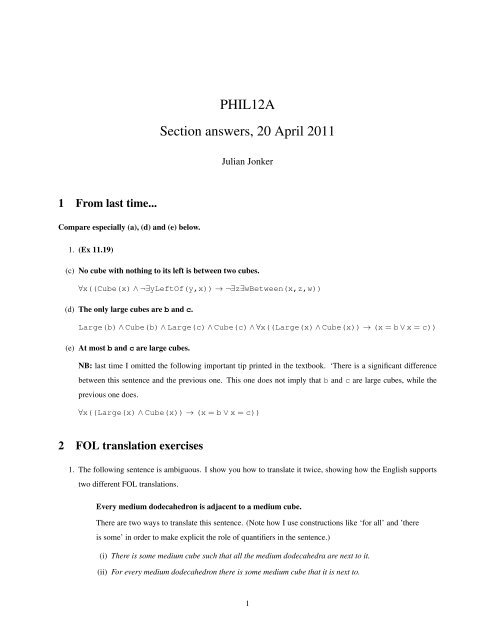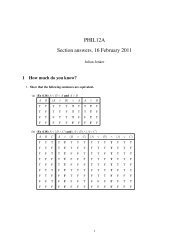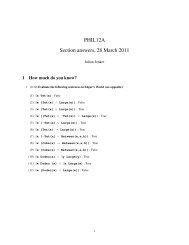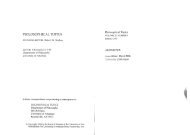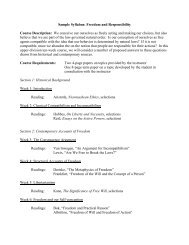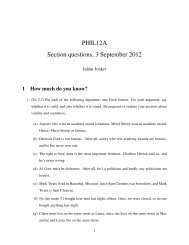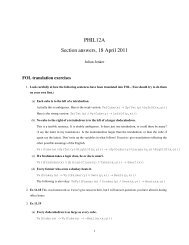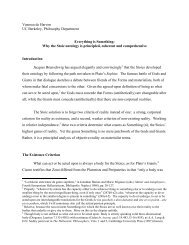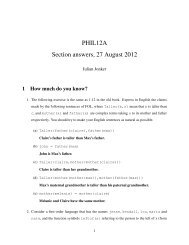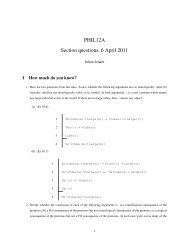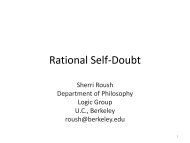PHIL12A Section answers, 20 April 2011 - Philosophy
PHIL12A Section answers, 20 April 2011 - Philosophy
PHIL12A Section answers, 20 April 2011 - Philosophy
Create successful ePaper yourself
Turn your PDF publications into a flip-book with our unique Google optimized e-Paper software.
<strong>PHIL12A</strong><strong>Section</strong> <strong>answers</strong>, <strong>20</strong> <strong>April</strong> <strong>20</strong>11Julian Jonker1 From last time...Compare especially (a), (d) and (e) below.1. (Ex 11.19)(c) No cube with nothing to its left is between two cubes.∀x((Cube(x) ∧ ¬∃yLeftOf(y,x)) → ¬∃z∃wBetween(x,z,w))(d) The only large cubes are b and c.Large(b) ∧ Cube(b) ∧ Large(c) ∧ Cube(c) ∧ ∀x((Large(x) ∧ Cube(x)) → (x = b ∨ x = c))(e) At most b and c are large cubes.NB: last time I omitted the following important tip printed in the textbook. ‘There is a significant differencebetween this sentence and the previous one. This one does not imply that b and c are large cubes, while theprevious one does.∀x((Large(x) ∧ Cube(x)) → (x = b ∨ x = c))2 FOL translation exercises1. The following sentence is ambiguous. I show you how to translate it twice, showing how the English supportstwo different FOL translations.Every medium dodecahedron is adjacent to a medium cube.There are two ways to translate this sentence. (Note how I use constructions like ‘for all’ and ’thereis some’ in order to make explicit the role of quantifiers in the sentence.)(i) There is some medium cube such that all the medium dodecahedra are next to it.(ii) For every medium dodecahedron there is some medium cube that it is next to.1
Here are the FOL translations:(i) ∃x[Cube(x) ∧ Medium(x) ∧ ∀y((Dodec(y) ∧ Medium(y)) → Adjoins(x,y))](ii) ∀x[(Dodec(x) ∧ Medium(x)) → ∃y(Cube(y) ∧ Medium(y) ∧ Adjoins(x,y))]2. One of the above translations is strong, and the other weak, in the sense that the strong sentence impliesthe weaker one, but not vice versa. Indicate which translation is which.(i) is the stronger claim. Whenever (i) is true, (ii) is true too. In other words, every model that makes (ii) truemakes (i) true. But there are models that make (ii) true but not (i). So it is not always the case that (i) is truewhen (ii) is true.3. (Ex 11.27 and 11.28) Here are two arguments, each of whose first premise is ambiguous. Translate eachargument into FOL twice (using sensible predicates), corresponding to the ambiguity in the first premise.Under one translation the conclusion follows: prove it. Under the other it does not: describe a situationin which the premises are true but the conclusion false.(a) (Ex 11.27)1 Everyone admires someone who has red hair.2 Anyone who admires himself is conceited.3 Someone with red hair is conceited.Here’s a translation that makes the argument valid:1 ∃x(Red(x) → ∀y(Admires(x,y)))2 ∀x(Admires(x,x) → Conceited(x))3 ∃x(Red(x) ∧ Conceited(x)The argument would be invalid if we had translated the first premise as the weaker:∀x∃y(Red(y) ∧ Admires(y,x)).(b) (Ex 11.28)1 All that glitters is not gold.2 This ring glitters.3 This ring is not gold.The following translation makes the argument valid:2
1 ∀x(Glitters(x) → ¬Gold(x))2 Glitters(ring)3 ¬Gold(ringThe following weaker translation of the first premise would make the argument invalid:¬∀x(Glitters(x) → Gold(x))3 Proofs with quantifiers1. Some of the following arguments are valid, some are not. Give an informal proof for those which are valid; forthe others, give counterexamples. I’ve done the first one.(a) (Ex 12.4)1 ∀y[Cube(y) ∨ Dodec(y)]2 ∀x[Cube(x) → Large(x)]3 ∃x¬Large(x)4 ∃xDodec(x)Proof. The third premise tells us that there is something which is not large. Let’s call this object d. Nowby universal instantiation we have the following:(1) Cube(d) ∨ Dodec(d)(2) Cube(d) → Large(d)By modus tollens on (2) above, we have that d is not a cube. But then by (1) above it must be the case thatd is a dodecahedron.Since d was an arbitrary object in the domain of discourse, we can by existential instantiation obtain∃xDodec(x), which is our desired conclusion.3
(b) (Ex 12.5)1 ∀y[Cube(y) ∨ Dodec(y)]2 ∀x[Cube(x) → Large(x)]3 ∃x¬Large(x)4 ∃x[Dodec(x) ∧ Small(x)]This argument is not valid. Suppose that there is a medium dodecahedron only. Then the premises are true(check this!) but the conclusion is false.(c) (Ex 12.8)1 ∀x[Cube(x) ∨ (Tet(x) ∧ Small(x))]2 ∃x[Large(x) ∧ BackOf(x,c)]3 ∃x[FrontOf(c,x) ∧ Cube(x)]Proof: By the second premise there is something which is large and behind c. Let’s call this object e. ByExistential Instantiation we get that e is large and that it is behind c. But since BackOf and FrontOfare inverses, we know that c is in front of e.Now by the first premise everything is either a cube or a small tetrahedron, so by Universal Instantiation,e is either a cube or a small tetrahedron. But we know that e is large – so it must be cube. So c is in frontof e and e is a cube. But now we use Existential Generalization in order to obtain our conclusion: thatthere is something that c is in front of and that is a cube.(d) (Ex 12.9)1 ∀x[(Cube(x) ∧ Large(x)) ∨ (Tet(x) ∧ Small(x))]2 ∀x[Tet(x) → BackOf(x,c)]3 ∀x[Small(x) → BackOf(x,c)]Proof: We’re going to reason about an arbitrary object – it could be any one. For convenience, we’ll call itj. We’ll show by Conditional Proof that if j is small then it is behind c. But since j is arbitrary, this willbe true of every object.Suppose j is small. By Universal Instantiation on the first premise we get that j is either a large cubeor a small tetrahedron. Since it is small, we know it is a tetrahedron. By Universal Instantiation on thesecond premise we get that if j is a tetrahedron then it is behind c. So, by modus ponens, j is behind4
c. So this shows that if j is small, then it is behind c. (In other words, we have proved Small(j) →BackOf(j,c).But j was arbitrary, so by Universal Generalization, we get that any small object is behind c, which is thedesired conclusion.5


